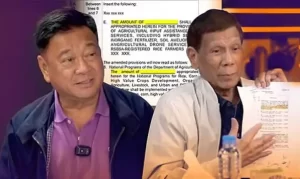Ever wondered how laws are finalized in Congress?
You may have heard of the Bicameral Conference Committee Report (Bicam Report), but did you know that lawmakers can leave certain provisions blank and fill them in later?😲
This controversial practice—”Fill in the Blanks” – ” Bicam Report Blanks “— has sparked debates over transparency, accountability, and legality.
In this comprehensive guide, we will break down:
✅ What a Bicam Report is 🔍
✅ How “Fill in the Blanks” works ✍️
✅ Legal and constitutional perspectives ⚖️
✅ Controversies and real-life case studies 🔥
✅ Recommendations for a more transparent legislative process 💡



Advertisement:

Bicam Report in Congress: “Fill in the Blanks” Validity Explained 🏛️📜
Table of Contents
Introduction: What is a Bicam Report? 📃
A Bicam Report is the final version of a bill that reconciles differences between the House of Representatives and the Senate. This process ensures that both chambers agree on a uniform version of a proposed law before it is sent to the President for approval. However, a lesser-known yet impactful mechanism—”Fill in the Blanks”—allows legislators to leave parts of a bill unfinished and insert details later. But is this valid and legal? 🤷
Let’s explore the details.
Understanding the Bicameral Conference Committee Report
| Entity | Role in the Process |
|---|---|
| House of Representatives | Initiates, debates, and amends bills before sending them to the Senate. |
| Senate | Reviews, amends, and proposes changes to House-approved bills. |
| Bicameral Conference Committee | Resolves differences between House and Senate versions of a bill. |
| Bill Authors and Sponsors | Propose and advocate for specific provisions. |
| Legislative Counsels and Legal Experts | Ensure that proposed amendments comply with legal frameworks. |
| Presiding Officers (Senate President, Speaker of the House) | Oversee deliberations and final approvals. |
How “Fill in the Blanks” Works in Congress 🖊️
“Fill in the Blanks” refers to leaving specific provisions undefined during a bill’s deliberation. Legislators then finalize these provisions at the last stage before approval.
Why Do Lawmakers Use This Mechanism?
- 🔄 Flexibility in Finalizing Budget Allocations – Some budget provisions require last-minute adjustments based on revenue estimates and executive agreements.
- ⏳ Time Constraints – Congress sometimes rushes to pass laws before session deadlines.
- 🤝 Political Compromises – To win support, lawmakers may defer key details until after initial approvals.
Legal Basis and Validity of “Fill in the Blanks” ⚖️
Key Legal Considerations:
| Legal Framework | Implication |
| 1987 Constitution of the Philippines | Requires that a bill undergo three readings in both chambers before becoming law. |
| Supreme Court Rulings | Past rulings have struck down last-minute insertions that were not deliberated properly. |
| Congressional Rules | Allows flexibility in budgetary matters, but lacks clear regulations for post-ratification insertions. |
Controversies Surrounding “Fill in the Blanks” 🚨
Common Concerns Raised:
❌ Lack of Transparency – The public often does not know what is inserted until after a bill is passed.
❌ Potential for Abuse – “Fill in the Blanks” can be misused to insert controversial provisions without debate.
❌ Allegations of “Midnight Insertions” – Some laws contain hidden provisions inserted at the last minute.
Case Studies: Real-Life Examples of “Fill in the Blanks” 🏛️
- National Budget Laws – Congress has adjusted budget figures after a bill was ratified. 📊
- Tax Reform Measures – Some tax provisions were added without public consultation. 💰
- Infrastructure Funding – Specific project allocations changed at the last minute. 🏗️
Best Practices & Recommendations ✅
🔹 Full Disclosure of Amendments – Any “Fill in the Blanks” changes should be documented and made public.
🔹 Public Hearings for Major Changes – Additional hearings should be held when significant provisions are inserted.
🔹 Real-Time Legislative Tracking – Implement a digital tracking system for amendments.
🔹 Stronger Oversight – Watchdog groups should be given access to final versions before approval.
Frequently Asked Questions (FAQ) 🤔
1. Is “Fill in the Blanks” legal?
It depends on how it is used. If it results in major post-ratification changes, courts may rule it unconstitutional.
2. Can citizens challenge a bill with “Fill in the Blanks”?
Yes! If changes violate constitutional provisions, the Supreme Court can declare the law invalid.
3. How can the public track last-minute changes?
By following Congressional reports, media coverage, and watchdog organizations like The Senate Journal or House Proceedings.
Disclaimer: Pinoy Trending Note ⚠️
Pinoy Trending does not own the content of this article, and all views, interpretations, and analyses presented herein are solely for informational and educational purposes. This article does not constitute legal advice and should not be used as a substitute for professional legal consultation.
While every effort has been made to provide accurate and up-to-date information, readers are strongly encouraged to verify details with official Congressional records, government sources, and legal experts before drawing any conclusions or making decisions based on the information provided in this article.
Pinoy Trending is not responsible for any actions taken based on the content of this article, and we urge readers to engage with authoritative sources and legal professionals when dealing with legislative matters.
References 📚
- Constitution of the Philippines (1987) – Official Gazette
- Supreme Court Rulings on Legislative Amendments – PH Judiciary Archive
- House and Senate Proceedings on Bicameral Reports – Congress Records
Conclusion: The Future of “Fill in the Blanks” in Congress 🏛️
While “Fill in the Blanks” offers flexibility in budgeting and policy-making, it also raises serious concerns about legislative integrity. Strengthening oversight and transparency is crucial to ensure that laws are crafted fairly, legally, and in the public’s best interest.
📢 What do you think? Should Congress reform “Fill in the Blanks” practices? Drop your thoughts in the comments! 💬
Josh is a seasoned content writer and journalist with over 15 years of experience creating impactful, accurate, and engaging content across industries like technology, healthcare, finance, and media. He specializes in translating complex topics into clear, accessible narratives and excels in technical documentation, editorial writing, and marketing materials.
A skilled journalist, Josh delivers in-depth features and articles that resonate with readers. Known for his attention to detail, research skills, and reliability, he is dedicated to producing high-quality content that informs, educates, and inspires.


